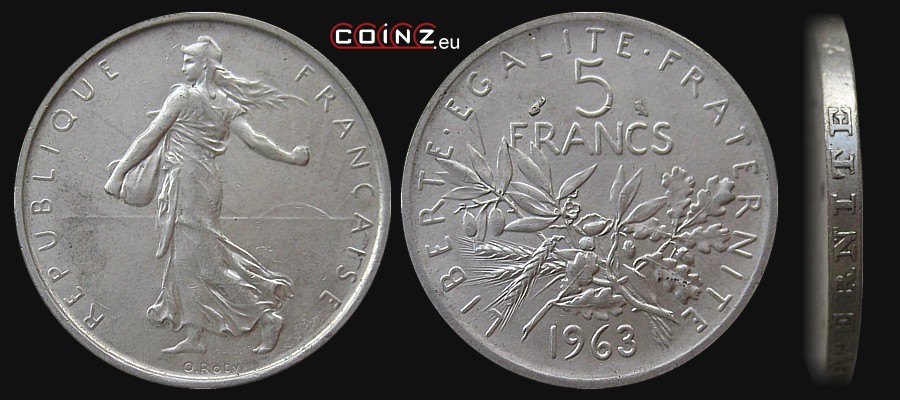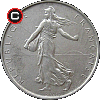5 francs FRANCE (1960-1969)



| diameter: | weight: | thickness: | alloy: |
| 29.0 mm | 12.0 g | 2.3 mm | Ag835Cu165 |
obverse:
in coin centre personification of France - figure of Marianne in Phrygian cap sowing cereal leftwards (La Semeuse), in the background the Sun hidden mostly below the horizon; along the left edge: REPUBLIQUE, along the right: FRANÇAISE (French Republic)
reverse:
in the coin centre olive and oak branches together with cereal ears; above in two lines face value: 5 / FRANCS; on the bottom year of issue; along the top edge motto of France: LIBERTE • EGALITE • FRATERNITE (liberty, equality, fraternity)
edge:
plain with convex inscription: * LIBERTE * EGALITE * FRATERNITE * (liberty, equality, fraternity)
issue date:
22 XII 1959
withdrawal date:
19 II 1980
designer:
Atelier de gravure (group of designers of the Paris Mint) based on design of Louis Oscar Roty (signature O.ROTY on the bottom of the obverse)
mint:
 La Monnaie de Paris (The Paris Mint), Paris (mint mark before face value 5 in the reverse, after face value 5 privy mark of mint's director Raymond Joly - owl)
La Monnaie de Paris (The Paris Mint), Paris (mint mark before face value 5 in the reverse, after face value 5 privy mark of mint's director Raymond Joly - owl)
mintage:
| 1960 | 55 082 000 | |
| 1961 | 15 630 000 | |
| 1962 | 42 500 000 | |
| 1963 | 37 936 000 | |
| 1964 | 32 378 000 | + 25 600 in annual boxed sets |
| 1965 | 5 121 000 | + 35 000 in annual boxed sets |
| 1966 | 5 010 000 | + 7 171 in annual boxed sets |
| 1967 | 700 000 | + 2 305 in annual boxed sets |
| 1968 | 354 000 | + 3 000 in annual boxed sets |
| 1969 | 498 000 | + 6 050 in annual boxed sets |
mint marks:
interesting facts:
last update: 20 XI 2013
coins catalogue :: katalog monet :: münzkatalog :: catalogue de monnaies :: catálogo de monedas :: catalogo monete :: каталог монет :: κέρματα κατάλογος :: COINZ.eu
© 2010-2025 :: Adam Kubicki :: COINZ.eu :: All rights reserved.


